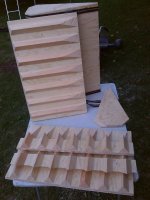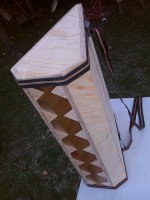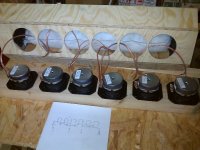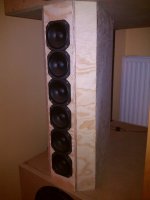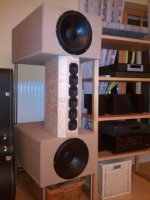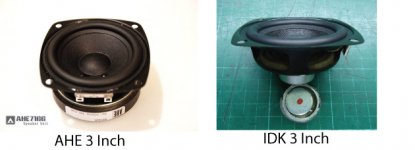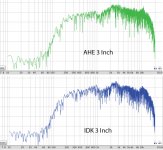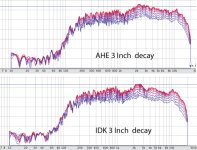Line Array Center to Center Driver Spacing
ginetto61 asked line array driver spacing. Take a look at my white paper on Near Field Line Array White Paper for guidelines. See:
http://www.audioroundtable.com/misc/nflawp.pdf
Of course closer is always better.
ginetto61 asked line array driver spacing. Take a look at my white paper on Near Field Line Array White Paper for guidelines. See:
http://www.audioroundtable.com/misc/nflawp.pdf
Of course closer is always better.
Hi Gino,
Regarding driver centre to centre spacing in line arrays with full range drivers....
Anyway I don't want to ramble on Percevals thread, feel free to PM me if you want more info.
Cheers
Derek.
Hello Derek thank you very much for your kind and valuable advice
I am trying to learn here from the scratch.
When i will have some knowledge i will contact you.
Thanks again and kind regards,
gino
ginetto61 asked line array driver spacing. Take a look at my white paper on Near Field Line Array White Paper for guidelines. See:
http://www.audioroundtable.com/misc/nflawp.pdf
Of course closer is always better.
Thanks a lot ! i have now material for the next weeks to read
I hope this will not beyond my ability to understand at least the basics.
Great stuff indeed.
Kindest regards,
gino
Thanks a lot ! i have now material for the next weeks to read
I hope this will not beyond my ability to understand at least the basics.
Great stuff indeed.
Kindest regards,
gino
If you take your time, read slowly, it's not that hard to understand.
I also read a lot of threads in here about arrays... and still reading!
Lots of amazing projects in here.
nice work
Thanks guys!
It's just a test box. Nothing really fancy. I just painted the baffle black, but the sides are still wood, no finishing. I'll keep that for when I really decide what and how I am going to finalise this.
Those BMR drivers look really interesting....
Bamboo for cabinets
Just a thought Percival,
If you can get Bamboo at a reasonable cost its a fabulous material to make your cabinets ( and racks, shelves, base's or anything really!) from.
Try to get the "pure woven stranded" construction rather than the " horizontal or vertical " construction.
Stranded bamboo has amazing acoustic properties , its a tightly woven lattice of highly compressed fibres ( natures carbon fibre ) with huge strength and its also beautiful...Just a rub down with oil and you are done!
MDF / fibre board is ok for prototypes, but once you have finalised your design go for bamboo if you can get it.
Cheers
D.
Just a thought Percival,
If you can get Bamboo at a reasonable cost its a fabulous material to make your cabinets ( and racks, shelves, base's or anything really!) from.
Try to get the "pure woven stranded" construction rather than the " horizontal or vertical " construction.
Stranded bamboo has amazing acoustic properties , its a tightly woven lattice of highly compressed fibres ( natures carbon fibre ) with huge strength and its also beautiful...Just a rub down with oil and you are done!
MDF / fibre board is ok for prototypes, but once you have finalised your design go for bamboo if you can get it.
Cheers
D.
Funny.
I am in a land where bamboo grows wildly, but I have never seen bamboo material sheets. I've seen tatamis, cushions made of woven plies, lunchboxes made of thin bamboo, but haven't seen bamboo sold like a sheet of plywood.
I am in a land where bamboo grows wildly, but I have never seen bamboo material sheets. I've seen tatamis, cushions made of woven plies, lunchboxes made of thin bamboo, but haven't seen bamboo sold like a sheet of plywood.
Hello perceval!
I tried also a line array using 6x 3" (Peerless TC9FD-18-08) because of following reasons:
1. almost fullrange (active crossover 24dB at 180Hz)
2. almost no reflections from floor and ceiling, because of concentrated vertical radiation on axis
My observations are:
- very flat measured response at listening position without any EQ
- Very 3-dimensional soundstage with space between every single instrument or singer
- can play very loud and still be precise (means 3-dimensional)
- the vertical sweet spot is only +-5cm at listening position (about 3,5m from base line)
In addition to the line array itself, the double bass configuration made the bass very dry and reduced the standing wave issue in my listening room dramatic.
Here are some pictures:
I have learned a lot of other things on that project, we can share if you like.
I tried also a line array using 6x 3" (Peerless TC9FD-18-08) because of following reasons:
1. almost fullrange (active crossover 24dB at 180Hz)
2. almost no reflections from floor and ceiling, because of concentrated vertical radiation on axis
My observations are:
- very flat measured response at listening position without any EQ
- Very 3-dimensional soundstage with space between every single instrument or singer
- can play very loud and still be precise (means 3-dimensional)
- the vertical sweet spot is only +-5cm at listening position (about 3,5m from base line)
In addition to the line array itself, the double bass configuration made the bass very dry and reduced the standing wave issue in my listening room dramatic.
Here are some pictures:
I have learned a lot of other things on that project, we can share if you like.
Attachments
Try cobbling up a pseudo transmission line arrangement like the TLAH if an open baffle array isn't practical.
This should work against a wall
This should work against a wall
Hello perceval!
I tried also a line array using 6x 3" (Peerless TC9FD-18-08) because of following reasons:
1. almost fullrange (active crossover 24dB at 180Hz)
2. almost no reflections from floor and ceiling, because of concentrated vertical radiation on axis
My observations are:
- very flat measured response at listening position without any EQ
- Very 3-dimensional soundstage with space between every single instrument or singer
- can play very loud and still be precise (means 3-dimensional)
- the vertical sweet spot is only +-5cm at listening position (about 3,5m from base line)
In addition to the line array itself, the double bass configuration made the bass very dry and reduced the standing wave issue in my listening room dramatic.
I have learned a lot of other things on that project, we can share if you like.
Nice balancing act there!
Yes, even with my far from stellar drivers, with my 9-driver array, if I sit in the middle, it sounds pretty good. No measurements yet. I need a quiet room and that only happens once a week!
I have considered adding one or two bass drivers to the array. I found a very low Qts (0.2) 10" driver that the online volume tool tells me I only needs a 4-liter (0.16cu.ft) sealed enclosure.
But that might not pass WAF....
I do like the fact that I can put it directly on the wall. I'll look up that TLAH.
Yep, that was my understanding... low Qts means weak bass.... but this site I am looking at swears it is a great low freq driver to be put in a small enclosure.
Ok, I need experienced eyes.
I took a few measurements from the 2 drivers I have at the moment.
Could someone tell me if I am throwing money away by spending 7 times more on one driver compared to the other?
Notes on both, when I listened and compared the drivers with my ears.
The AHE is a paper cone and plays a little louder (better sensitivity, I guess) and emphasises the higher registry of the frequencies. Airy, vocals are lighter and higher. It is hefty for its size, using old fashion ferrite (and strong) magnet, at 375g (13oz) each.
The AHE is $20 each.
The IDK is a fiberglass cone and feels deeper in the frequency range. Not as airy as the other, but warmer. I lose a bit of definition on hi-hats hits for example, but vocals have a much warmer feel to them. Much lighter, using neonydium (and very weak) magnet, at 85g (3oz) each.
Here's a few images:
I took a few measurements from the 2 drivers I have at the moment.
Could someone tell me if I am throwing money away by spending 7 times more on one driver compared to the other?
Notes on both, when I listened and compared the drivers with my ears.
The AHE is a paper cone and plays a little louder (better sensitivity, I guess) and emphasises the higher registry of the frequencies. Airy, vocals are lighter and higher. It is hefty for its size, using old fashion ferrite (and strong) magnet, at 375g (13oz) each.
The AHE is $20 each.
The IDK is a fiberglass cone and feels deeper in the frequency range. Not as airy as the other, but warmer. I lose a bit of definition on hi-hats hits for example, but vocals have a much warmer feel to them. Much lighter, using neonydium (and very weak) magnet, at 85g (3oz) each.
Here's a few images:
Attachments
The AHE is a paper cone....using old fashion ferrite (and strong) magnet, at 375g (13oz) each.
The IDK is a fiberglass cone....using neodymium (and very weak) magnet, at 85g (3oz) each.
Stop! You don't know that. The neo magnet may well be the stronger of the two. You cannot compare different magnet material by weight. Pound for pound, neo is very much stronger than ferrite. Until you have the T/S parameters of the two drivers, you cannot make any statement about the relative BL, hence Qts of the drivers on the visual premise that the smaller magnet must be the weaker.
Bob
Sorry, what I meant is that the ferrite speakers can pick up my screwdriver easily. The neo doesn't pick up anything.
Self shielded magnet structure doesn't mean B field at VC gap is weaker. In all likelyhood, NIB magnet is stronger motor. I think response of the AHE looks smoother.
Self shielded magnet structure doesn't mean B field at VC gap is weaker. In all likelyhood, NIB magnet is stronger motor. I think response of the AHE looks smoother.
So, would it be 7 times worth it?
The AHE is $20 ... the IDK is $3.
IMHO.... 😀 No 😀
But I have a weak spot for cheap drivers that sound good. If you like the sound of the $3 one, all the better.
But I have a weak spot for cheap drivers that sound good. If you like the sound of the $3 one, all the better.
- Status
- Not open for further replies.
- Home
- Loudspeakers
- Full Range
- Short Line Array (line source) build
